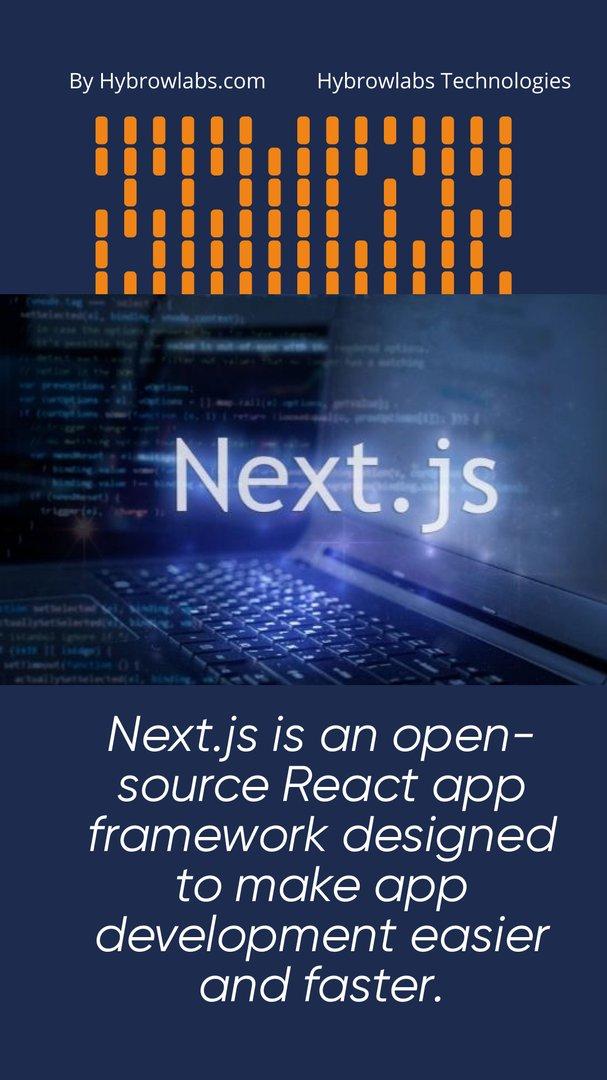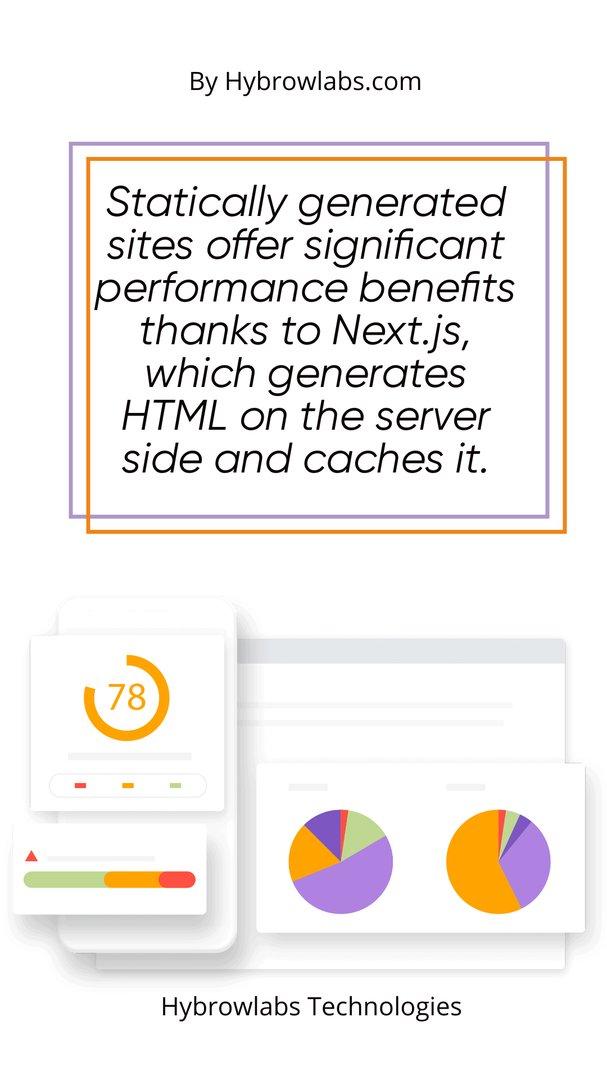What Is NextJS?

Next.js is an open-source React application framework designed to make the development of React applications easier and faster. It provides a modern stack that includes features such as server-side rendering, static page generation, and built-in routing.
What is static site generation?

Static site generation is a process that creates a set of static HTML, CSS, and JavaScript files from a combination of content sources such as Markdown files and template files. It's gaining popularity due to the rise of static site frameworks such as Next.js, which makes it easier for developers to create high-performance websites and web applications.
With static site generation, developers are able to create websites with fast load times and no need for server-side processing. This makes them ideal for businesses or organizations that have a lot of content since they don't need to be concerned with the resources associated with maintaining a dynamic website.
Why are statically generated sites performant?
Statically generated sites offer significant performance benefits thanks to Next.js.
With Next.js, developers can easily create sites where the HTML is generated on the server side and cached. This results in improved loading times and reduced latency.
Additionally, since the HTML is already pre-generated we can cache it on the edge using services like Cloudflare, and edge features from Vercel or Netlify improve the performance.
Additionally, NextJS offers developers a range of customization options to build and deploy applications with greater speed and efficiency. This makes NextJS an ideal choice for businesses looking for a robust yet flexible solution for their projects.
Installation And Setup of NextJS

Installation and setup of NextJS is a straightforward process that involves installing the relevant dependencies, creating a NextJS project, and configuring the project for deployment.
Just run the following command to create a NextJs project:
npx create-next-app@latest
Once installed, developers can quickly create dynamic web applications that are optimized for both performance and scalability.
Deploying NextJS applications has never been easier. With providers like Netlify, Vercel and Cloudflare, developers can get up and running in minutes with an end-to-end CI/CD pipeline in place. This makes it incredibly easy to deploy and manage NextJS applications, as well as extend their capabilities with a wide range of features and integrations.
The Basic Features Of NextJS
A: Routing with Next/Link
Next.js has simplified the process of routing with its built-in library, Next/Link. This library allows developers to easily create dynamic, nested routes within their applications. As a result, developers no longer need to manually create each route, and can now quickly configure the URLs for their webpages in a much more organized fashion. In addition, Next/Link has also made it easier to handle navigation between pages, as well as fetching data from a backend API. All of these features make Next.js an extremely powerful framework for building fast and efficient web applications.
B: Server Side Rendering (SSR)
By utilizing server-side rendering, Next.js can deliver pages quickly and efficiently, providing users with a seamless experience. With its growing library of plugins and integrations, Next.js is becoming a popular choice for building modern web applications. There are two options for SSR:
C: Static Site Generation (getStaticProps and getStaticPaths)
Next makes static site generation a breeze. Specifically, the getStaticProps and getStaticPaths features of Next.js allow developers to easily generate static HTML and pre-render pages for improved performance and SEO.
D: Dynamic Site Generation (getServerSideProps)
The introduction of getServerSideProps to Next.js has made it easier than ever to create dynamic websites with server-side rendering capabilities. This new feature allows you to fetch data at build time, enabling developers to create sites that are more performant and secure. With getServerSideProps, developers can use the same codebase they are familiar with while taking advantage of all the benefits that come with server-side rendering. So we get to have flexibility where we want static site generation and where we want Dynamic Site Generation.
In Summary
As an example, Amazon boasts an inventory of millions of products. It would be unfeasible to create all of these product pages as static content for the website.
On the other hand, the landing pages of the categories are much more important, and using static site generation for the same would be really helpful in boosting the performance of the website.
A: Code Splitting & Dynamic Imports
Code Splitting DynamicImports is an important feature for further optimizing performance. This feature utilizes a dynamic import() syntax to automatically split code into separate bundles and helps developers to optimize their web application's loading performance.
NextJs gives us a fine-grain control of which part of the HTML should be rendered as HTML and which part of it should be delivered as JS.
By using Code Splitting and DynamicImports, developers can create smaller, more focused bundles that can be loaded in parallel, allowing for faster loading times and improved user experience. This technology is especially useful for large applications with many dependencies, making it an invaluable tool for developers looking to improve their web application's performance.
B: Automatic Image Optimization in NextJS
NextJS makes it easy to optimize your images for web performance with its built-in Automatic Image Optimization feature. This feature allows you to easily compress and transform images on-the-fly so that they load faster on your website. By doing so, you can improve your website's load time without any additional effort. Additionally, NextJS can also detect the size of the image being requested and automatically adjust the image size accordingly, ensuring optimal performance for all visitors.
C: Prefetching & Preloading in NextJS
One of the standout features of NextJS is its prefetching and preloading capabilities, which allow developers to create faster-loading webpages by pre-loading data before it is needed. This can dramatically reduce loading times and improve user experience, making NextJS an ideal choice for developers looking to build efficient, user-friendly websites.
D: Automatic Bundling & Optimization with Turbopack
With the introduction of Turbopack, Next.js users now have access to a powerful tool that automatically bundles and optimizes their code for faster loading and performance. Turbopack will enable users to quickly and easily deploy their projects, allowing them to focus on creating great experiences for their customers.
E: Incremental static site generation
Next.js added the ability for incremental static site generation easier than ever. With Next.js, developers can quickly and easily build static sites that are optimized for SEO and loading performance, while also taking advantage of the flexibility of server-rendering technology.
F: Hot Module Replacement (HMR)
HMR enables developers to update code quickly, without losing the state of the application and without having to restart the entire application. This helps to speed up and enhance the development process, making it easier and faster to iterate on code. This is especially helpful if you are working on a project with a large codebase, as it can help to reduce the time and effort spent on manual restarts.
Hot Module Replacement (HMR) has become an essential part of delivering an optimal developer experience. Obviously, Next.js provides a comprehensive HMR experience that exceed developer expectations.
G: CSS-in-JS with styled-jsx and more.
Next.js works well with all the styling libraries of React.js. It offers many features and capabilities, including the ability to use CSS-in-JS with styled-jsx. This feature allows developers to write CSS in the same JavaScript file as their components, allowing for easy styling of components without needing extra files or tools.
Additionally, Next.js supports pre-processing of styles with either PostCSS or Sass, making it easier to achieve consistent styling across multiple projects. With this powerful suite of tools, developers can quickly and easily create modern web applications using Next.js.
Comparison With Other Frameworks
When it comes to comparing Next.js to other frameworks, there are a few key areas where it stands out. First, Next.js is built with performance in mind, making it ideal for developers looking to build fast, efficient web applications. Additionally, Next.js is highly customizable, making it easy to build unique applications that fit the specific needs of the user.
Finally, Next.js also offers a wide range of features, including automatic image optimization, prefetching and preloading, automatic bundling and optimization with Turbopack, HMR, and CSS-in-JS with styled-jsx and more. These features make Next.js a powerful and versatile framework that can be used to create powerful and efficient web applications.
Conclusion
NextJS is a powerful framework that allows you to build beautiful, fast React apps without writing any HTML or JavaScript code on the server side. If you're looking for a way to quickly build robust web applications.
To learn more about Next.js, be sure to check out - Hybrowlabs Next.js Services






a3dc85.jpg)

.jpg)
fd8f11.png)


.jpg)
.jpg)